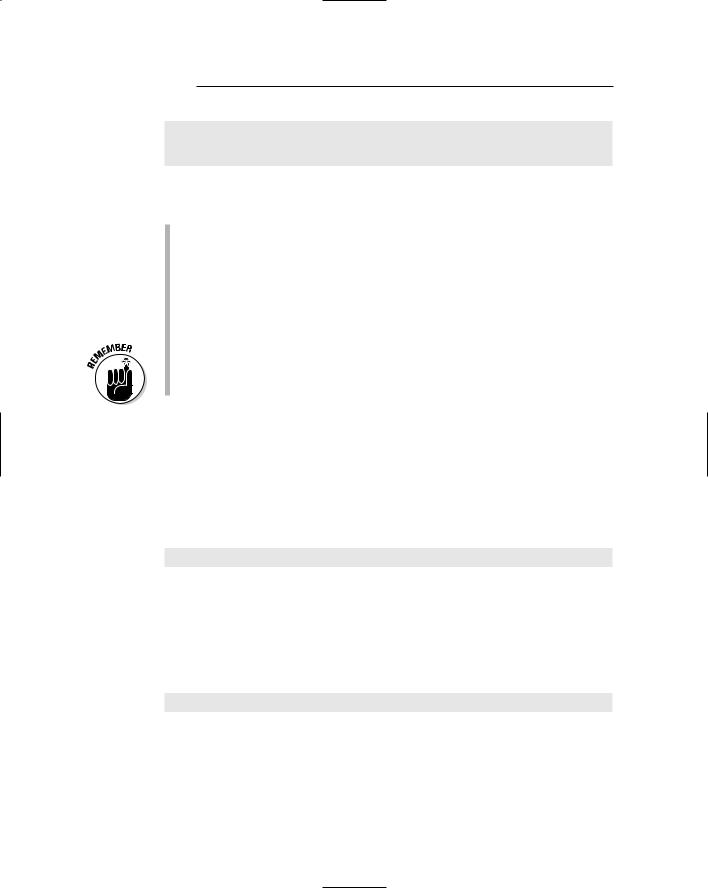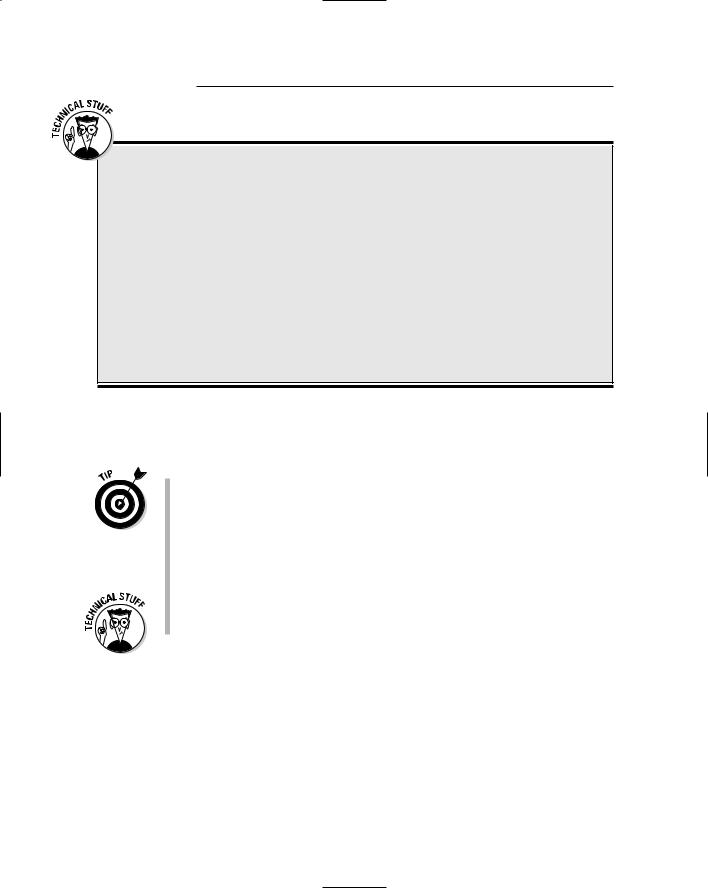
- •Table of Contents
- •Introduction
- •About This Here Dummies Approach
- •How to Work the Examples in This Book
- •Foolish Assumptions
- •Icons Used in This Book
- •Final Thots
- •The C Development Cycle
- •From Text File to Program
- •The source code (text file)
- •The compiler and the linker
- •Running the final result
- •Save It! Compile and Link It! Run It!
- •Reediting your source code file
- •Dealing with the Heartbreak of Errors
- •The autopsy
- •Repairing the malodorous program
- •Now try this error!
- •The Big Picture
- •Other C Language Components
- •Pop Quiz!
- •The Helpful RULES Program
- •The importance of being \n
- •Breaking up lines\ is easy to do
- •The reward
- •More on printf()
- •Printing funky text
- •Escape from printf()!
- •A bit of justification
- •Putting scanf together
- •The miracle of scanf()
- •Experimentation time!
- •Adding Comments
- •A big, hairy program with comments
- •Why are comments necessary?
- •Bizarr-o comments
- •C++ comments
- •Using Comments to Disable
- •The More I Want, the More I gets()
- •Another completely rude program example
- •And now, the bad news about gets()
- •The Virtues of puts()
- •Another silly command-prompt program
- •puts() and gets() in action
- •More insults
- •puts() can print variables
- •The Ever-Changing Variable
- •Strings change
- •Running the KITTY
- •Hello, integer
- •Using an integer variable in the Methuselah program
- •Assigning values to numeric variables
- •Entering numeric values from the keyboard
- •The atoi() function
- •So how old is this Methuselah guy, anyway?
- •Basic mathematical symbols
- •How much longer do you have to live to break the Methuselah record?
- •The direct result
- •Variable names verboten and not
- •Presetting variable values
- •The old random-sampler variable program
- •Maybe you want to chance two pints?
- •Multiple declarations
- •Constants and Variables
- •Dreaming up and defining constants
- •The handy shortcut
- •The #define directive
- •Real, live constant variables
- •Numbers in C
- •Why use integers? Why not just make every number floating-point?
- •Integer types (short, long, wide, fat, and so on)
- •How to Make a Number Float
- •The E notation stuff
- •Single-character variables
- •Char in action
- •Stuffing characters into character variables
- •Reading and Writing Single Characters
- •The getchar() function
- •The putchar() function
- •Character Variables As Values
- •Unhappily incrementing your weight
- •Bonus program! (One that may even have a purpose in life)
- •The Sacred Order of Precedence
- •A problem from the pages of the dentistry final exam
- •The confounding magic-pellets problem
- •Using parentheses to mess up the order of precedence
- •The computer-genie program example
- •The if keyword, up close and impersonal
- •A question of formatting the if statement
- •The final solution to the income-tax problem
- •Covering all the possibilities with else
- •The if format with else
- •The strange case of else-if and even more decisions
- •Bonus program! The really, really smart genie
- •The World of if without Values
- •The problem with getchar()
- •Meanwhile, back to the GREATER problem
- •Another, bolder example
- •Exposing Flaws in logic
- •A solution (but not the best one)
- •A better solution, using logic
- •A logical AND program for you
- •For Going Loopy
- •For doing things over and over, use the for keyword
- •Having fun whilst counting to 100
- •Beware of infinite loops!
- •Breaking out of a loop
- •The break keyword
- •The Art of Incrementation
- •O, to count backward
- •How counting backward fits into the for loop
- •More Incrementation Madness
- •Leaping loops!
- •Counting to 1,000 by fives
- •Cryptic C operator symbols, Volume III: The madness continues
- •The answers
- •The Lowdown on while Loops
- •Whiling away the hours
- •Deciding between a while loop and a for loop
- •Replacing those unsightly for(;;) loops with elegant while loops
- •C from the inside out
- •The Down-Low on Upside-Down do-while Loops
- •The devil made me do-while it!
- •do-while details
- •The always kosher number-checking do-while loop
- •Break the Brave and Continue the Fool
- •The continue keyword
- •The Sneaky switch-case Loops
- •The switch-case Solution to the LOBBY Program
- •The Old switch-case Trick
- •The Special Relationship between while and switch-case
- •A potentially redundant program in need of a function
- •The noble jerk() function
- •Prototyping Your Functions
- •Prototypical prototyping problems
- •A sneaky way to avoid prototyping problems
- •The Tao of Functions
- •The function format
- •How to name your functions
- •Adding some important tension
- •Making a global variable
- •An example of a global variable in a real, live program
- •Marching a Value Off to a Function
- •How to send a value to a function
- •Avoiding variable confusion (must reading)
- •Functions That Return Stuff
- •Something for your troubles
- •Finally, the computer tells you how smart it thinks you are
- •Return to sender with the return keyword
- •Now you can understand the main() function
- •Give that human a bonus!
- •Writing your own dot-H file
- •A final warning about header files
- •What the #defines Are Up To
- •Avoiding the Topic of Macros
- •A Quick Review of printf()
- •The printf() Escape Sequences
- •The printf() escape-sequence testing program deluxe
- •Putting PRINTFUN to the test
- •The Complex printf() Format
- •The printf() Conversion Characters
- •More on Math
- •Taking your math problems to a higher power
- •Putting pow() into use
- •Rooting out the root
- •Strange Math? You Got It!
- •Something Really Odd to End Your Day
- •The perils of using a++
- •Oh, and the same thing applies to a --
- •Reflections on the strange ++a phenomenon
- •On Being Random
- •Using the rand() function
- •Planting a random-number seed
- •Randoming up the RANDOM program
- •Streamlining the randomizer
- •Arrays
- •Strings
- •Structures
- •Pointers
- •Linked Lists
- •Binary Operators
- •Interacting with the Command Line
- •Disk Access
- •Interacting with the Operating System
- •Building Big Programs
- •Use the Command-Line History
- •Use a Context-Colored Text Editor
- •Carefully Name Your Variables
- •Breaking Out of a Loop
- •Work on One Thing at a Time
- •Break Up Your Code
- •Simplify
- •Talk through the Program
- •Set Breakpoints
- •Monitor Your Variables
- •Document Your Work
- •Use Debugging Tools
- •Use a C Optimizer
- •Read More Books!
- •Setting Things Up
- •The C language compiler
- •The place to put your stuff
- •Making Programs
- •Finding your learn directory or folder
- •Running an editor
- •Compiling and linking
- •Index

310 Part IV: C Level
Able |
Baker |
Charlie |
1 |
2 |
3 |
Alpha |
Beta |
Gamma |
Though the \ts in the printf statements look sloppy, the output is definitely organized. Tabular, dude!
The “tab stops” are preset to every eighth column in C’s output. Using a \t inserts a given number of space characters in the output, lining up the next bit of text at the next tab stop. I mention this because some people assume that the tab always moves over eight (or however many) characters. That is not the case.
The \f and \v characters display special symbols at the Windows com mand prompt. Rather than a form feed, \f displays the ankh character. Rather than a vertical tab, \v displays the male symbol.
As long as you know a character’s hexadecimal code value, you can always get it displayed by using the \x escape sequence. Just plug in the hexadecimal code and there you go!
The Complex printf() Format
The printf() function can also be used to display the contents of variables, which you have been seeing throughout this book with integer variables and the %d placeholder, character variables and %c, and so on. To make it happen, printf() uses this format:
printf(“format_string”[,var[,...]]);
Text still appears in double quotes, but after it’s used to display the values in variables, it becomes a format string. (It’s still the same text in double quotes.) The format string is followed by one or more variables, var.
Those var variables are plugged in to appropriate spots in the format_string according to special percent-sign placeholders. Those percent-sign place holders are called conversion characters. For example:
printf(“Yeah, I think %s is a jerk, too.\n”,jerk);
The format string is text that printf() displays on the screen: Yeah, I think ____ is a jerk, too. The %s is a conversion character — a blank — that must be filled by a string of text. (I call them placeholders, but the lords of C claim that they’re conversion characters.)

Chapter 24: The printf() Chapter 311
After the format string is a comma and then jerk. The jerk is a string vari able whose contents replace the %s in printf()’s output.
You can specify any number of conversion characters in printf()’s format string. Each conversion character, however, must have a cor responding variable; three %s characters would require three string variables.
Yeah, this works like fill-in-the-blanks; the % conversion characters are the blanks.
You can specify both strings of text and numbers by using the proper conversion characters, as described in the next section.
Refer to Figure 4-2, in Chapter 4, for an illustration of how the conver sion characters work with variables in a printf() statement.
The printf() Conversion Characters
Table 24-2 lists all the printf() conversion characters in the known universe — even those you haven’t seen before and some you may never see again.
Table 24-2 |
The printf() Conversion Characters |
Conversion Character |
Displays Argument (Variable’s Contents) As |
%c |
Single character |
|
|
%d |
Signed decimal integer (int) |
|
|
%e |
Signed floating-point value in E notation |
|
|
%f |
Signed floating-point value (float) |
|
|
%g |
Signed value in %e or %f format, whichever is shorter |
|
|
%i |
Signed decimal integer (int) |
|
|
%o |
Unsigned octal (base 8) integer (int) |
|
|
%s |
String of text |
|
|
%u |
Unsigned decimal integer (int) |
|
|
%x |
Unsigned hexadecimal (base 16) integer (int) |
|
|

312 Part IV: C Level
Additional formatting stuff
Your C compiler’s documentation should contain a list of additional printf() formatting infor mation, bonus characters that can be used in conjunction with the conversion characters to additionally format printf()’s output. That information is too complex and detailed to list here for every compiler. Instead, look up printf in your online reference manual and note these formatting sections:
Flags
Width specifiers
Precision specifiers
Input-size modifiers
You don’t need this information now for under standing the C programming language. However, it comes in handy as you begin working with numbers or require a little fancier output than what you have done with printf() in this chapter.
In addition to the conversion characters in Table 24-2, three other characters exist: %p, %n and %%. The %p and %n are advanced conversion characters, beyond the scope of this book. The %% merely prints a % on the screen.
As with the escape sequences, the conversion characters are something you use often but never remember. I advise tacking a sticky note to this page for future reference.
The %x, %e, and %g conversion characters also have uppercase equiva lents: %X, %E and %G. By using capital letters rather than lowercase, you ensure that any letters in the output are all listed as uppercase. For exam ple, %x would display a hexadecimal value as 1ba2, but %X would display 1BA2. Otherwise, the conversion character’s behavior is the same.
%p is used to print a value as a pointer. Pointers are covered in this book’s companion, C All-in-One Desk Reference For Dummies (Wiley).
